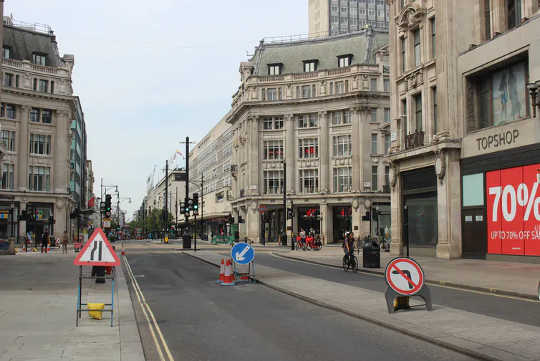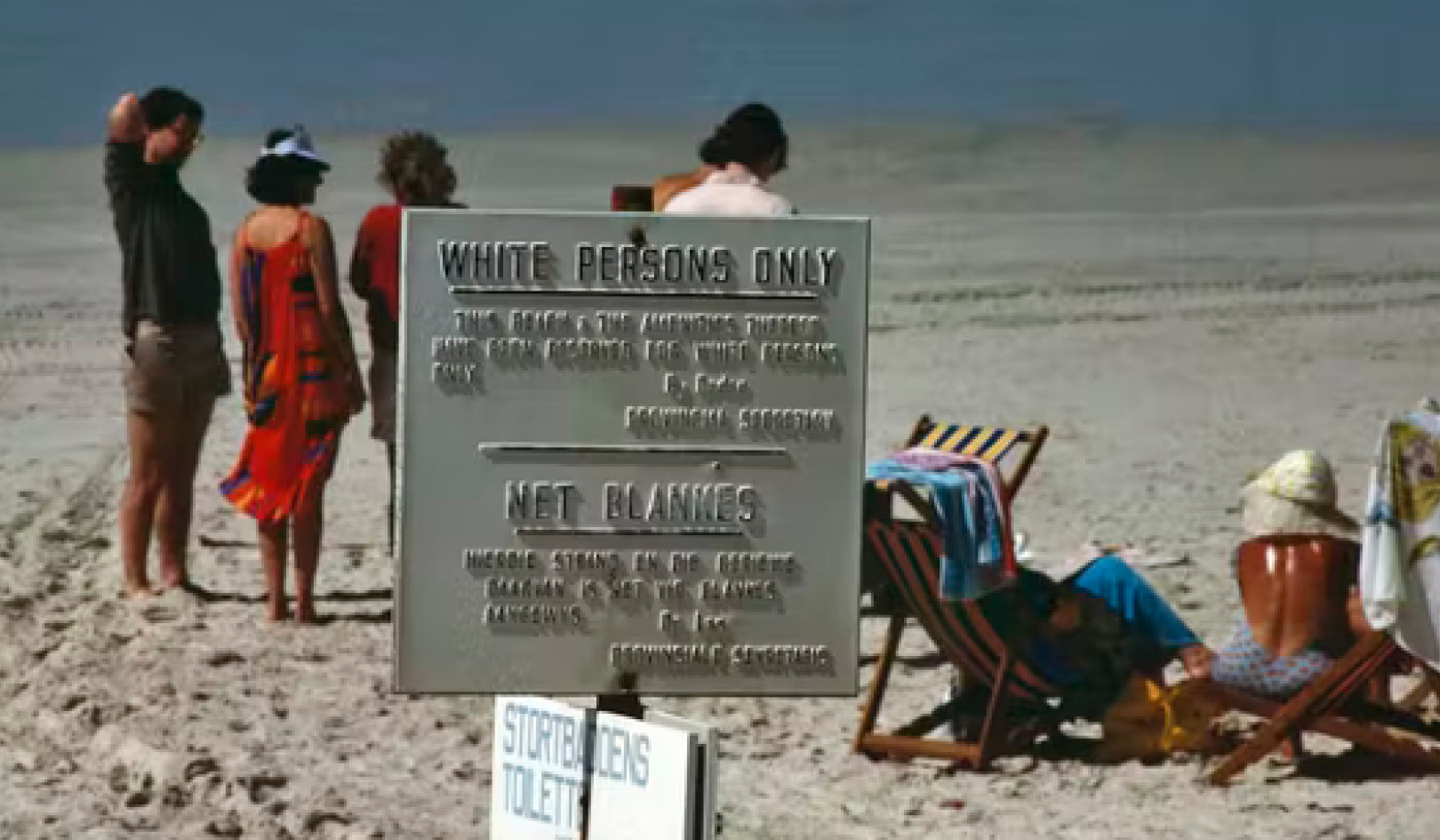
Oxford Street, London, empty in May 2020. CK Travels/Shutterstock
The most COVID-19 lockdowns were accompanied by sobering news from the UK’s high streets. The Arcadia Group, which owns some of the UK’s most iconic high street clothing retail outlets – Topshop, Topman and Dorothy Perkins, among others – has gone into administration.
Meanwhile, the UK’s oldest retail chain, Debenhams, is closing. Around 12,000 people are set to lose their jobs, on top of 6,500 already lost this year, after efforts to rescue the retailer fell through.
All of this comes at the end of a decade that saw a major decline of British high streets. Since 2007, some 556 retail companies have failed, with the closure of almost 39,100 stores and the loss of 468,809 jobs as shoppers move online.
These impacts vary geographically. Many of the closures are concentrated in city centres. But beyond the city core, there remains the prospect that smaller town centres and suburban high streets might emerge stronger in 2021 as people learn to love shopping locally again.
A downwards trend
Long before the pandemic, high street retailers were facing stiff competition from out-of-town shopping centres and, more importantly, online retailing.
According to the UK’s Office for National Statistics, online sales in November 2006 totalled 2.8% of all retail sales. The latest data shows that online sales in October 2020 amounted to 28.1% of total retail sales – but this had already risen to 21.5% in November 2019, before COVID-19 reached the UK.
The pandemic has exacerbated the downwards slide of high streets. Thousands of the shops closed in March 2020 have not reopened.
But there are markedly different patterns from town to town. Local high streets with more convenience shopping, hot food takeaways and other essential businesses have generally performed much better than city centres dominated by department stores and shops selling higher-value items.
Take Greater Manchester, for example. Google’s Community Mobility data shows that visitor numbers to retail and recreation spaces in smaller town centres like Bury and Rochdale have recovered faster. In contrast, Manchester city centre has continued to perform much more poorly as commuters continue to work at home and avoid public transport.
It may actually be that COVID-19 has encouraged more people to shop locally, and that they have begun to see more value in their local town centres. This raises a fundamental question about the future of city centre retailing.
London provides a good example. Now that the first COVID vaccine has been approved by the UK government, central London will undoubtedly eventually return to some of its former vitality, attracting tourists and other visitors to enjoy its eclectic night-time economy, theatres, galleries and museums.
But, if more people prefer to work at home and not head into central London from the suburbs, the retail retraction we have witnessed in 2020 will only worsen.
Hollow cities
Retail and recreation visitor numbers in central London – the City of Westminster and the City of London – have been particularly affected by COVID-19 when compared to the wider city.
Overall average daily visitor numbers to retail and recreation spaces within Westminster and the City of London fell by 70.6% and 76.7% respectively between February 15 and November 24 2020. The most recent lockdown, which commenced on November 5, saw retail and recreation visitor numbers fall to 90%-92% below pre-COVID levels.
In comparison, overall average retail and recreation visitor numbers in inner London and outer London councils were down by 54.9% and 38.4% respectively. Our mapping of the impact of COVID-19 on visitor journeys to retail and recreation places across London effectively reveals a “doughnut city”: shoppers have abandoned the centre, while suburbs have remained rather more resilient.
The future of city centre high streets after COVID-19 is uncertain. One answer would be to suggest the cities will bounce back as vaccinated workers and shoppers return, and that their shopping streets will live on.
However, this does not take into account the scars left by COVID-19. Take London’s iconic Oxford Street as an example. Since late March, department store John Lewis has halved the size of its Oxford Street store. House of Fraser, another department store, is to be part-repurposed as offices and a gym. Topshop’s flagship store on the street is at risk of closure.
With online retail behemoth Amazon emerging as one of the only winners of COVID-19, we have to be realistic about the future of central London as a shopping hub.
Retail rents are declining fast in the West End, and it is likely that prime retail sites will be converted to offices or even homes. The UK government has already loosened planning regulations that permits the conversion of shops to residential uses without planning permission – all part of the drive to solve the housing crisis.
We are witnessing a switch in the use of urban space, as people working from home increasingly spend time, and money, outside city centres. The hope is that smaller high streets and those local centres most valued as hubs of community life, not just places of consumption, will witness a renaissance in 2021. The viability of larger centres – Birmingham, Manchester, and especially London – looks to have fundamentally unravelled.
About the Authors
Paul J. Maginn, Associate Professor of Urban/Regional Planning, University of Western Australia and Philip Hubbard, Professor of Urban Studies, King's College London
This article is republished from The Conversation under a Creative Commons license. Read the original article.
Recommended books:
Capital in the Twenty-First Century
by Thomas Piketty. (Translated by Arthur Goldhammer)
 In Capital in the Twenty-First Century, Thomas Piketty analyzes a unique collection of data from twenty countries, ranging as far back as the eighteenth century, to uncover key economic and social patterns. But economic trends are not acts of God. Political action has curbed dangerous inequalities in the past, says Thomas Piketty, and may do so again. A work of extraordinary ambition, originality, and rigor, Capital in the Twenty-First Century reorients our understanding of economic history and confronts us with sobering lessons for today. His findings will transform debate and set the agenda for the next generation of thought about wealth and inequality.
In Capital in the Twenty-First Century, Thomas Piketty analyzes a unique collection of data from twenty countries, ranging as far back as the eighteenth century, to uncover key economic and social patterns. But economic trends are not acts of God. Political action has curbed dangerous inequalities in the past, says Thomas Piketty, and may do so again. A work of extraordinary ambition, originality, and rigor, Capital in the Twenty-First Century reorients our understanding of economic history and confronts us with sobering lessons for today. His findings will transform debate and set the agenda for the next generation of thought about wealth and inequality.
Click here for more info and/or to order this book on Amazon.
Nature's Fortune: How Business and Society Thrive by Investing in Nature
by Mark R. Tercek and Jonathan S. Adams.
 What is nature worth? The answer to this question—which traditionally has been framed in environmental terms—is revolutionizing the way we do business. In Nature’s Fortune, Mark Tercek, CEO of The Nature Conservancy and former investment banker, and science writer Jonathan Adams argue that nature is not only the foundation of human well-being, but also the smartest commercial investment any business or government can make. The forests, floodplains, and oyster reefs often seen simply as raw materials or as obstacles to be cleared in the name of progress are, in fact as important to our future prosperity as technology or law or business innovation. Nature’s Fortune offers an essential guide to the world’s economic—and environmental—well-being.
What is nature worth? The answer to this question—which traditionally has been framed in environmental terms—is revolutionizing the way we do business. In Nature’s Fortune, Mark Tercek, CEO of The Nature Conservancy and former investment banker, and science writer Jonathan Adams argue that nature is not only the foundation of human well-being, but also the smartest commercial investment any business or government can make. The forests, floodplains, and oyster reefs often seen simply as raw materials or as obstacles to be cleared in the name of progress are, in fact as important to our future prosperity as technology or law or business innovation. Nature’s Fortune offers an essential guide to the world’s economic—and environmental—well-being.
Click here for more info and/or to order this book on Amazon.
Beyond Outrage: What has gone wrong with our economy and our democracy, and how to fix it -- by Robert B. Reich
 In this timely book, Robert B. Reich argues that nothing good happens in Washington unless citizens are energized and organized to make sure Washington acts in the public good. The first step is to see the big picture. Beyond Outrage connects the dots, showing why the increasing share of income and wealth going to the top has hobbled jobs and growth for everyone else, undermining our democracy; caused Americans to become increasingly cynical about public life; and turned many Americans against one another. He also explains why the proposals of the “regressive right” are dead wrong and provides a clear roadmap of what must be done instead. Here’s a plan for action for everyone who cares about the future of America.
In this timely book, Robert B. Reich argues that nothing good happens in Washington unless citizens are energized and organized to make sure Washington acts in the public good. The first step is to see the big picture. Beyond Outrage connects the dots, showing why the increasing share of income and wealth going to the top has hobbled jobs and growth for everyone else, undermining our democracy; caused Americans to become increasingly cynical about public life; and turned many Americans against one another. He also explains why the proposals of the “regressive right” are dead wrong and provides a clear roadmap of what must be done instead. Here’s a plan for action for everyone who cares about the future of America.
Click here for more info or to order this book on Amazon.
This Changes Everything: Occupy Wall Street and the 99% Movement
by Sarah van Gelder and staff of YES! Magazine.
 This Changes Everything shows how the Occupy movement is shifting the way people view themselves and the world, the kind of society they believe is possible, and their own involvement in creating a society that works for the 99% rather than just the 1%. Attempts to pigeonhole this decentralized, fast-evolving movement have led to confusion and misperception. In this volume, the editors of YES! Magazine bring together voices from inside and outside the protests to convey the issues, possibilities, and personalities associated with the Occupy Wall Street movement. This book features contributions from Naomi Klein, David Korten, Rebecca Solnit, Ralph Nader, and others, as well as Occupy activists who were there from the beginning.
This Changes Everything shows how the Occupy movement is shifting the way people view themselves and the world, the kind of society they believe is possible, and their own involvement in creating a society that works for the 99% rather than just the 1%. Attempts to pigeonhole this decentralized, fast-evolving movement have led to confusion and misperception. In this volume, the editors of YES! Magazine bring together voices from inside and outside the protests to convey the issues, possibilities, and personalities associated with the Occupy Wall Street movement. This book features contributions from Naomi Klein, David Korten, Rebecca Solnit, Ralph Nader, and others, as well as Occupy activists who were there from the beginning.
Click here for more info and/or to order this book on Amazon.























